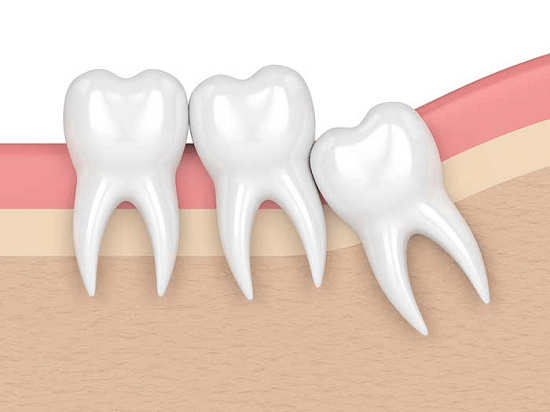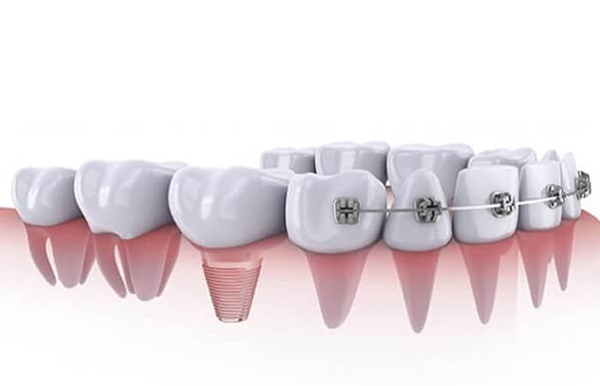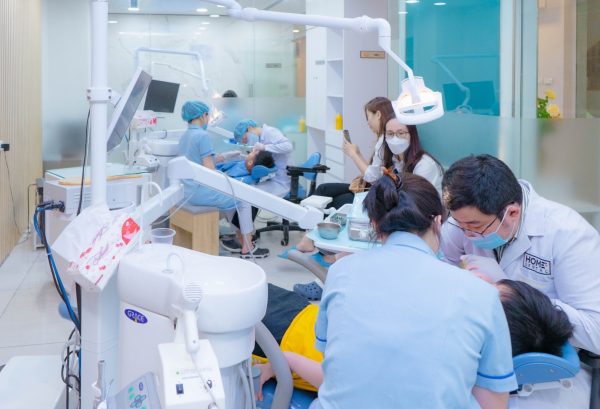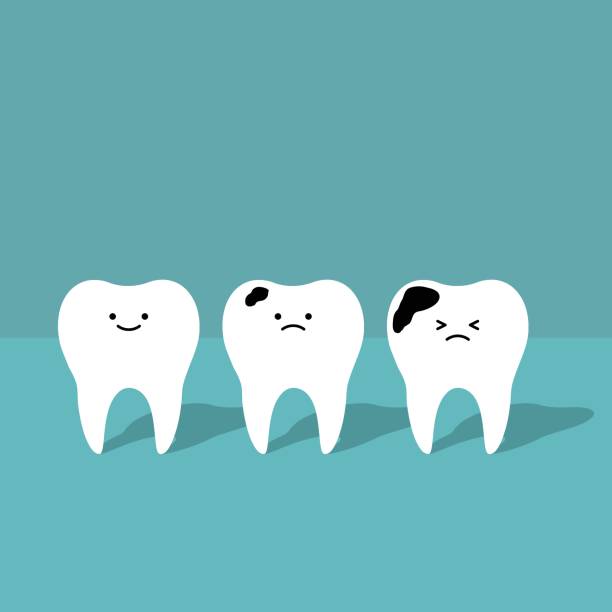Contents
Distinguishing common types of misaligned wisdom teeth
Mesial wisdom teeth
Mesial wisdom teeth is a quite common condition. The tooth tends to tilt at an angle of about 45 degrees toward the position of the 7th tooth, which means the tooth is angled toward the front of the mouth.
Above the gum, you will see the tooth partially erupting if you look closely, but it actually leans on the adjacent tooth. This type of wisdom tooth can cause displacement and pressure for its adjacent one, so it is necessary that patients have a treatment plan to be examined and treated as soon as possible.
Distal wisdom teeth
Completely opposite to mesial wisdom teeth, distal wisdom teeth grow toward the back of the mouth and also is a less common case of misaligned teeth. The deviation of the tooth will determine whether it is necessary to remove the tooth.
A normal tooth is tilted at an angle close to zero degrees; but usually, a wisdom tooth will erupt with a slight deviation. You can wait 1-2 years according to the advice of the doctor to determine exactly whether this wisdom tooth should be removed or not.

Vertically impacted wisdom teeth
When the teeth grow straight but cannot emerge on the gums because the crowns are too big, patients will suffer from discomfort and pain.
In some cases, between the wisdom tooth and the adjacent tooth there are too large interdental spaces, causing periodontitis, bad breath, gingivitis and tooth decay.
Vertical wisdom teeth rarely have to be removed because most of them will cause no problems and grow normally. The doctor only advises to remove them provided that they cause overcrowding in the back of the mouth, putting pressure on the underside of the adjacent tooth or bone.
Horizontal wisdom teeth
Wisdom teeth that grow horizontally will create an angle of 90 degrees with teeth number 7. Most of these cases can only be seen when taking x-rays of the entire jaw. The adjacent teeth will be pierced horizontally as the wisdom teeth grow longer. For a long time, they can easily cause cysts around the teeth, which are very dangerous, and even damage the 7th tooth root.
Horizontal wisdom teeth will grow under the upper jaw bone in most cases and also cause the most severe pain of all wisdom teeth types. To relieve pain and prevent damage to the adjacent teeth, horizontal wisdom teeth must be removed with a surgical extraction.
Safe wisdom tooth extraction procedure
In case of misaligned teeth, extraction is necessary to avoid more dangerous complications and dental diseases in the long run. Wisdom tooth extraction is a basic dental procedure which is used to remove one or more wisdom teeth. The following is a detailed wisdom tooth extraction procedure:
Step 1: Anesthesia
The first step in wisdom tooth extraction is to administer anesthesia to numb the area around the tooth. This can be either a local anesthetic that numbs only the tooth and surrounding area or a general anesthetic that puts you to sleep during the procedure. Depending on each patient’s specific condition, different types of anesthesia will be used.
Step 2: Incision
Once the extraction area is numb, the dentist will make an incision in the gum tissue to expose the tooth and bone. In this step, the dentist needs ingenuity and skills to take action precisely.
Step 3: Removal of Tooth
Using forceps, the dentist will gently rock the tooth back and forth to loosen it from the jawbone. Once the tooth is loose, it will be removed from the socket.
Step 4: Cleaning
After the tooth is removed, the dentist will clean the socket to remove any debris or infection. This step is really essential to keep the wound protected from bacteria, avoid infection that can cause complications later in the procedure.
Step 5: Stitches
If necessary, the dentist will close the incision with stitches. Nowadays the most common stitches are dissolvable stitches that are usually self-dissolving and do not require removal. However, in some cases, the dentist needs to use non-dissolvable stitches. Then, the patient has to come back later to have these stitches removed.
Step 6: Recovery
After the procedure, the patient will be given gauze to bite down on to help stop any bleeding. The patient will also be given instructions on how to care for the extraction site, including how to clean it and what foods to avoid. It is important to rest and avoid strenuous activity for the first few days after the procedure to allow for proper healing. Patients also need to take medicines according to the prescription.
Above is the traditional wisdom tooth extraction procedure. Nowadays, there is modern technique to help the procedure take place quicker and less painful. That is the Piezotome method. This method involves the Piezotome technology. In this method, instead of making an incision in the patient’s gum tissue like the traditional method, ultrasound waves are used to separate the tooth and the ligaments that connect it with the jaw. As a result, the tooth can be removed easily and gently, causing no pain during or after the surgery. This technique is not only used in tooth extraction but is widely used in many other surgical dental treatments. It causes no pain and swelling after surgery and also reduces the risk of complications.
Wisdom tooth extraction is a routine procedure that is generally safe and effective. Following the above steps can help ensure a successful extraction and a speedy recovery. If you are experiencing any issues with your wisdom teeth, consult with your dentist to determine if extraction is necessary.
3 important notes for wisdom tooth extraction
Before the tooth extraction
Choose a dental address with a team of good, experienced doctors, good service and reasonable prices.
Before the extraction day, you need to eat enough, sleep 8 hours a day and do moderate sports to stay healthy. Especially try to drink lots of water.
You also need to share with the doctor your health status and allergy/current medications to be able to safely remove wisdom teeth.
Teeth should be extracted between 8 o’clock to 9 o’clock in the morning and 1 o’clock or 2 o’clock in the afternoon. Extracting teeth after eating is reasonable because at that time our body is full of energy and the stomach works well. Also, you will also have to refrain from eating for half a day after getting your wisdom teeth removed, so it is important to eat before the surgery.
During the tooth extraction
When starting treatment, it is necessary to keep being cheerful and optimistic.
Before removing the wisdom tooth root, the doctor will inject a local anesthetic to the client’s jaw so all sensations in the jaw will now disappear. When the tooth is completely extracted and the anesthetic is gone, the feeling will return.
Many people are worried that pulling out a wisdom tooth from their jaw will hurt and bleed a lot.
According to Dr.Nguyen Anh Ngoc, wisdom tooth extraction is not painful nor is it too scary. We don’t feel anything during the extraction, but after extraction, we will experience bleeding, slight swelling of the gums, pain, and numbness in both jaws. However, a few days later (often 2 to 3 days) the discomfort will gradually decrease.
What to do after the tooth extraction?
5 things you should do after wisdom tooth extraction
- Taking antibiotics to reduce pain and swelling such as ibuprofen, paracetamol… American dentists claim that ibuprofen is the best medicine to relieve pain from removing wisdom teeth.
- Apply cold compress alternately with hot compress to get rid of edema and bruises in the mouth area
- Eat grounded, pounded and soft food
- Rest for the first 1-2 days
- Before going to bed, raise your head higher than usual to facilitate blood circulation and limit bleeding.
6 things you should not do after wisdom tooth extraction
- Do not drive, do hard work
- Do not do strong sports, avoid moving the arch area
- Do not eat prohibited foods, spicy, sticky foods such as ice cream, hot pot, sticky rice, chips, mashed potatoes as they stick to the teeth and make the gums more sensitive.
- Do not bite or put sharp and hard objects into the extraction area
- Do not remove the blood clot on the alveolar bone
- Do not smoke, drink alcoholic beverages or carbonated drinks.
In conclusion, there are 4 common types of misalignment of wisdom teeth. Misaligned wisdom teeth cause so much pain and problems, therefore they need to be removed as soon as possible with a safe extracting procedure. All types of wisdom teeth that are slightly or severely misaligned are completely treated by the team of doctors at Home Dental after a short time with reasonable prices and dedicated care. With the use of Piezotome technology, wisdom teeth extraction at Home Dental is effective, safe and gentle. Customers will not have to go through too much pain during and after the procedure.















